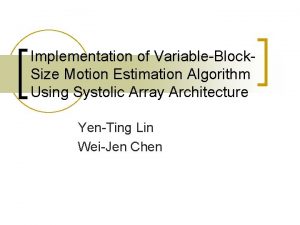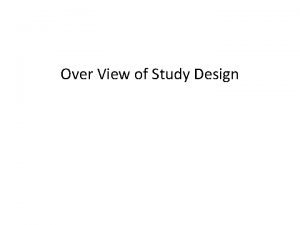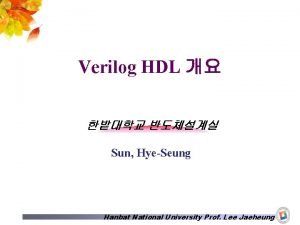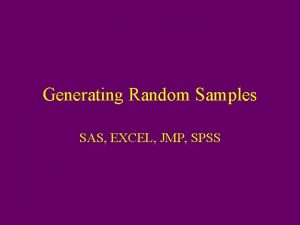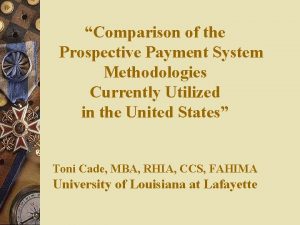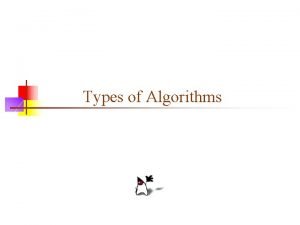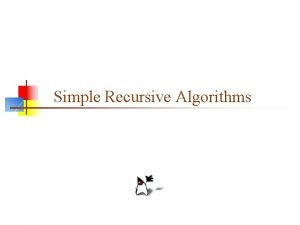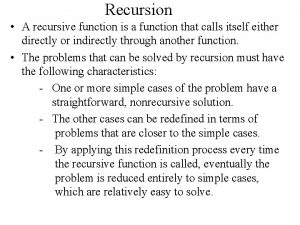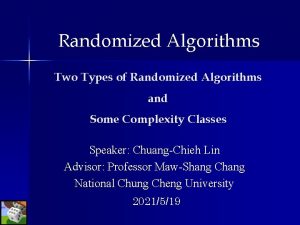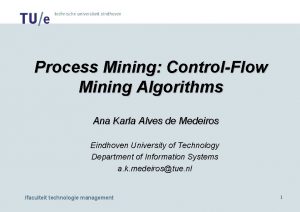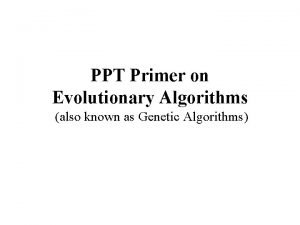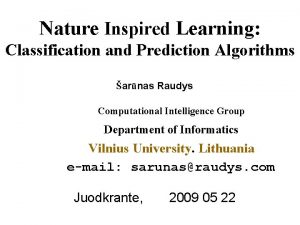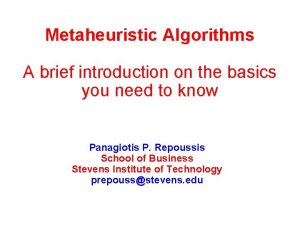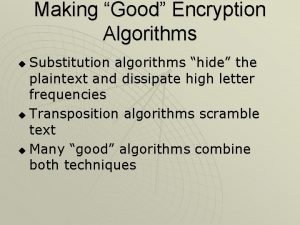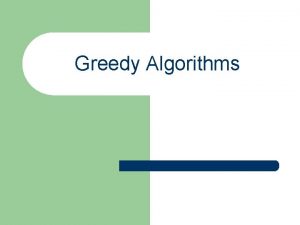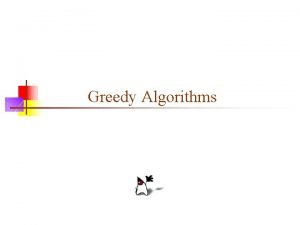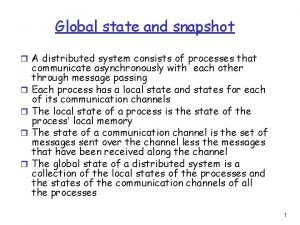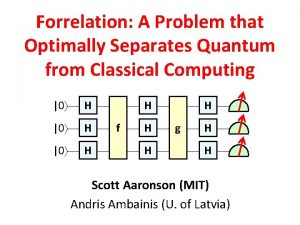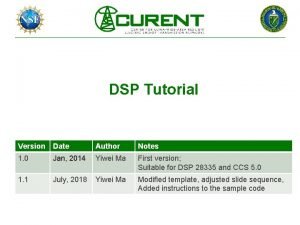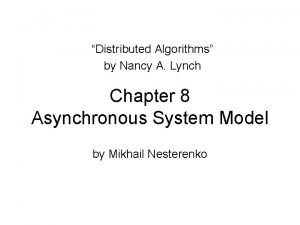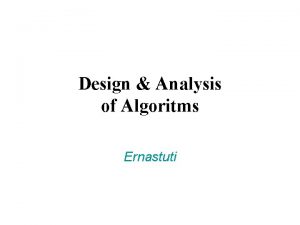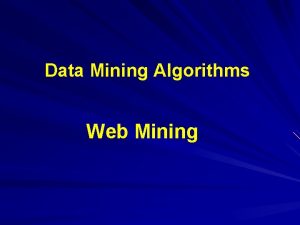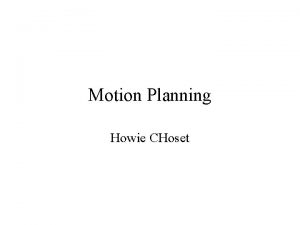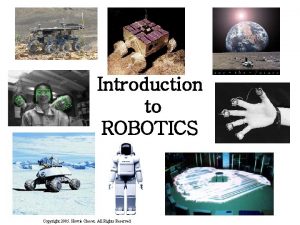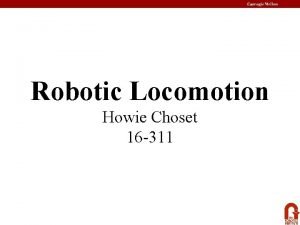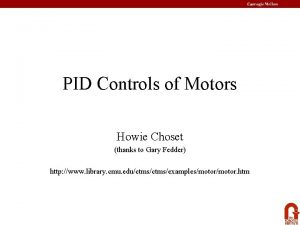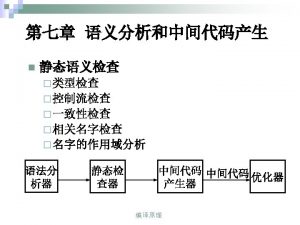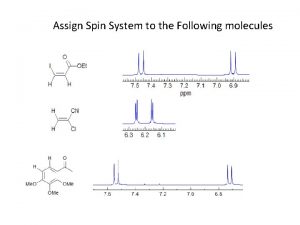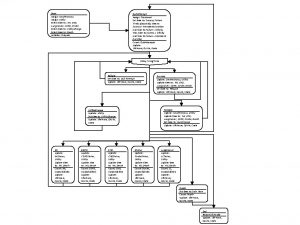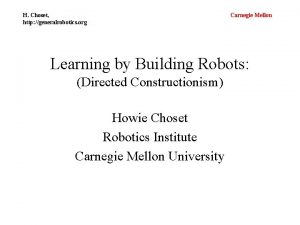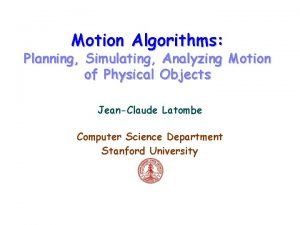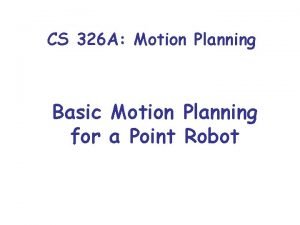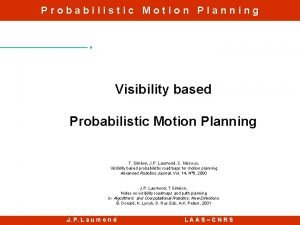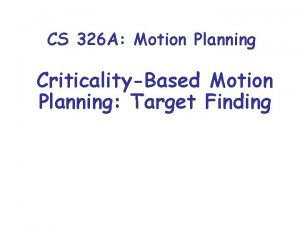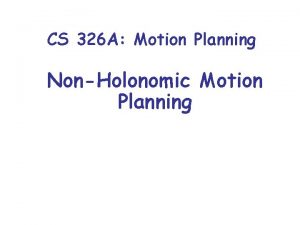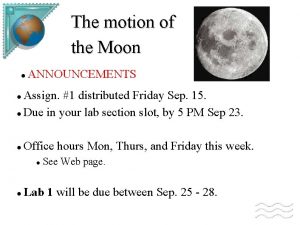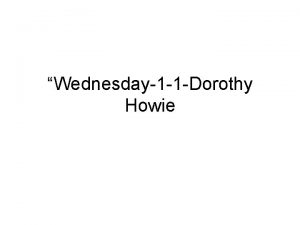Motion Planning Howie CHoset Assign HW Algorithms StartGoal























































- Slides: 55

Motion Planning Howie CHoset

Assign HW

Algorithms – Start-Goal Methods – Map-Based Approaches – Cellular Decompositions

Motion Planning Statement If W denotes the robot’s workspace, And Ci denotes the i’th obstacle, Then the robot’s free space, FS, is defined as: FS = W - ( U Ci ) And a path c C 0 is c : [0, 1] g FS where c(0) is qstart and c(1) is qgoal

What if the robot is not a point? The Scout should probably not be modeled as a point. . . b a Nor should robots with extended linkages that may contact obstacles. . .

Configuration Space “Quiz” Where do we put ? 360 A b q. A 270 B 180 b a 90 q. B 0 An obstacle in the robot’s workspace 45 a 90 135 Torus (wraps horizontally and vertically) 180

Configuration Space Obstacle How do we get from A to B ? Reference configuration 360 q. A A b 270 B 180 b a 90 q. B 0 An obstacle in the robot’s workspace 45 a 90 135 The C-space representation of this obstacle… 180

Two Link Path Thanks to Ken Goldberg

Two Link Path

Map-Based Approaches: Roadmap Theory • Properties of a roadmap: – Accessibility: there exists a collision-free path from the start to the road map – Departability: there exists a collision-free path from the roadmap to the goal. – Connectivity: there exists a collision-free path from the start to the goal (on the roadmap). a roadmap exists a path exists l Examples of Roadmaps l – Generalized Voronoi Graph (GVG) – Visibility Graph

Roadmap: Visibility Graph • Formed by connecting all “visible” vertices, the start point and the end point, to each other • For two points to be “visible” no obstacle can exist between them – Paths exist on the perimeter of obstacles • In our example, this produces the shortest path with respect to the L 2 metric. However, the close proximity of paths to obstacles makes it dangerous

The Visibility Graph in Action (Part 1) • First, draw lines of sight from the start and goal to all “visible” vertices and corners of the world. goal start

The Visibility Graph in Action (Part 2) • Second, draw lines of sight from every vertex of every obstacle like before. Remember lines along edges are also lines of sight. goal start

The Visibility Graph in Action (Part 3) • Second, draw lines of sight from every vertex of every obstacle like before. Remember lines along edges are also lines of sight. goal start

The Visibility Graph in Action (Part 4) • Second, draw lines of sight from every vertex of every obstacle like before. Remember lines along edges are also lines of sight. goal start

The Visibility Graph (Done) • Repeat until you’re done. goal start

Visibility Graph Overview • Start with a map of the world, draw lines of sight from the start and goal to every “corner” of the world and vertex of the obstacles, not cutting through any obstacles. • Draw lines of sight from every vertex of every obstacle like above. Lines along edges of obstacles are lines of sight too, since they don’t pass through the obstacles. • If the map was in Configuration space, each line potentially represents part of a path from the start to the goal.

Roadmap: GVG • A GVG is formed by paths equidistant from the two closest objects • Remember “spokes”, start and goal • This generates a very safe roadmap which avoids obstacles as much as possible

Distance to Obstacle(s)

Two-Equidistant • Two-equidistant surface

More Rigorous Definition Going through obstacles SSij Two-equidistant face

General Voronoi Diagram

What about concave obstacles? vs

What about concave obstacles? vs

What about concave obstacles? vs

Two-Equidistant • Two-equidistant surface Two-equidistant surjective surface Two-equidistant Face Sij

Voronoi Diagram: Metrics

Voronoi Diagram (L 2) Note the curved edges

Voronoi Diagram (L 1) Note the lack of curved edges

Exact Cell vs. Approximate Cell • Cell: simple region

Adjacency Graph – Node correspond to a cell – Edge connects nodes of adjacent cells • Two cells are adjacent if they share a common boundary c 14 c 2 c 5 c 7 c 8 c 1 c c 11 c 13 10 c 3 c 6 c 9 c 12 c 14 c 7 c 15 c 4 c 2 c 5 c 15 c 8 c 11 c 10 c 3 c 6 c 9 c 13 c 12

Set Notation

Examples

Definition

Cell Decompositions: Trapezoidal Decomposition • • A way to divide the world into smaller regions Assume a polygonal world

Cell Decompositions: Trapezoidal Decomposition • Simply draw a vertical line from each vertex until you hit an obstacle. This reduces the world to a union of trapezoid-shaped cells

Applications: Coverage • By reducing the world to cells, we’ve essentially abstracted the world to a graph.

Find a path • By reducing the world to cells, we’ve essentially abstracted the world to a graph.

Find a path • With an adjacency graph, a path from start to goal can be found by simple traversal start goal

Find a path • With an adjacency graph, a path from start to goal can be found by simple traversal start goal

Find a path • With an adjacency graph, a path from start to goal can be found by simple traversal start goal

Find a path • With an adjacency graph, a path from start to goal can be found by simple traversal start goal

Find a path • With an adjacency graph, a path from start to goal can be found by simple traversal start goal

Find a path • With an adjacency graph, a path from start to goal can be found by simple traversal start goal

Find a path • With an adjacency graph, a path from start to goal can be found by simple traversal start goal

Find a path • With an adjacency graph, a path from start to goal can be found by simple traversal start goal

Find a path • With an adjacency graph, a path from start to goal can be found by simple traversal start goal

Find a path • With an adjacency graph, a path from start to goal can be found by simple traversal start goal

Find a path • With an adjacency graph, a path from start to goal can be found by simple traversal start goal

Connect Midpoints of Traps

Applications: Coverage • First, a distinction between sensor and detector must be made • Sensor: Senses obstacles • Detector: What actually does the coverage • We’ll be observing the simple case of having an omniscient sensor and having the detector’s footprint equal to the robot’s footprint

Cell Decompositions: Trapezoidal Decomposition • How is this useful? Well, trapezoids can easily be covered with simple back-and-forth sweeping motions. If we cover all the trapezoids, we can effectively cover the entire “reachable” world.

Applications: Coverage • Simply visit all the nodes, performing a sweeping motion in each, and you’re done.

Boustrophedon Decomposition

Conclusion: Complete Overview • The Basics – – Motion Planning Statement The World and Robot Configuration Space Metrics • Path Planning Algorithms – Start-Goal Methods • Lumelsky Bug Algorithms • Potential Charge Functions • The Wavefront Planner – Map-Based Approaches • Generalized Voronoi Graphs • Visibility Graphs – Cellular Decompositions => Coverage • Done with Motion Planning!
 Diane howie
Diane howie Sarah howie
Sarah howie Motion estimation algorithms
Motion estimation algorithms Did investigator assign exposures
Did investigator assign exposures Ascom unite assign
Ascom unite assign Verilog for문 합성
Verilog for문 합성 Ascom unite connectivity manager
Ascom unite connectivity manager Cutter number examples
Cutter number examples Web assign
Web assign Jmp import excel
Jmp import excel Verilog assign 조건문
Verilog assign 조건문 A computer software program that assign appropriate ms-drgs
A computer software program that assign appropriate ms-drgs Type of range of motion
Type of range of motion Shm equations physics
Shm equations physics An object in motion stays in motion
An object in motion stays in motion Chapter 2 section 1 describing motion answer key
Chapter 2 section 1 describing motion answer key Chapter 2 motion section 1 describing motion answer key
Chapter 2 motion section 1 describing motion answer key Section 1 describing motion worksheet answer key
Section 1 describing motion worksheet answer key Chapter 1 lesson 2 describing motion answer key
Chapter 1 lesson 2 describing motion answer key Motion section 1 describing motion
Motion section 1 describing motion Strategic planning vs tactical planning
Strategic planning vs tactical planning Planning balance sheet in urban planning
Planning balance sheet in urban planning Role segmentation workforce planning
Role segmentation workforce planning N planning
N planning Aggregate planning is capacity planning for:
Aggregate planning is capacity planning for: Long term plan and short term plan
Long term plan and short term plan Types of language planning slideshare
Types of language planning slideshare Aggregate planning is capacity planning for
Aggregate planning is capacity planning for Aggregate planning is capacity planning for
Aggregate planning is capacity planning for Computational thinking algorithms and programming
Computational thinking algorithms and programming Types of algorithm
Types of algorithm Simple recursive algorithms.
Simple recursive algorithms. 1001 design
1001 design Safe patient handling algorithms
Safe patient handling algorithms Define recursive function
Define recursive function Types of randomized algorithms
Types of randomized algorithms Process mining algorithms
Process mining algorithms Evolutionary algorithms ppt
Evolutionary algorithms ppt Nature-inspired learning algorithms
Nature-inspired learning algorithms Tabu search tsp
Tabu search tsp Making good encryption algorithms
Making good encryption algorithms Algorithm analysis examples
Algorithm analysis examples Statistical algorithms
Statistical algorithms Professor ajit diwan
Professor ajit diwan Advantage and disadvantage of greedy algorithm
Advantage and disadvantage of greedy algorithm N/a greedy
N/a greedy Global state in distributed system
Global state in distributed system Classical algorithms for forrelation
Classical algorithms for forrelation Aprioti
Aprioti Dsp programming tutorial
Dsp programming tutorial Distributed algorithms nancy lynch
Distributed algorithms nancy lynch Analysis of algorithms
Analysis of algorithms Association analysis: basic concepts and algorithms
Association analysis: basic concepts and algorithms Virtual web view
Virtual web view Fftooo
Fftooo Amit agarwal princeton
Amit agarwal princeton


